Using Technology to Manage Childhood Obesity
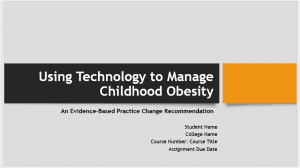
Hello. Welcome to today’s Evidence-Based Practice Change Recommendation presentation. More specifically, we will delve into using technology to manage childhood obesity.
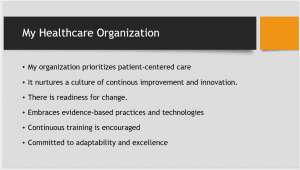
The healthcare organization I currently work in prioritizes patient-centered care. It encourages continuous innovation and improvement, which is indicative of readiness for change. Furthermore, the staff embraces evidence-based technologies and practices. In addition, staff members are always encouraged to take part in continuous training and development opportunities to ensure that they are updated on the latest advancements in healthcare. Notably, our organization is always committed to excellence and adaptability, making it a rewarding refuge in which to receive care and work.
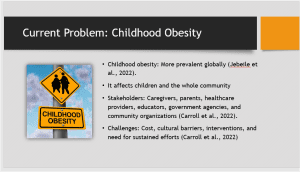
The current health problem addressed herein is childhood obesity. Childhood obesity has become more prevalent globally. Childhood obesity causes different health issues, including psychosocial, cardiometabolic disorders, and premature death, which transition into adulthood (Jebeile et al., 2022). The scope of childhood obesity affects not only personal health but also families, policymakers, healthcare providers, and the community at large. The stakeholders involved in addressing this issue include parents or caregivers, healthcare providers, educators, community organizations, and government agencies (Carroll et al., 2022). Challenges that can be encountered during the implementation of these changes include cultural barriers, cost, interventions, and the need for sustained efforts (Carroll et al., 2022).
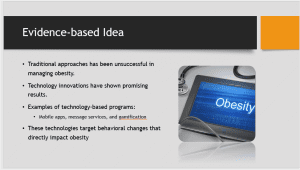
The evidence-based idea proposed is the use of technology-based programs in the management of childhood obesity as behavioral interventions. Traditional methods of management of obesity have been unsuccessful. Nonetheless, technological innovations have shown promising results in the management of childhood obesity (Hammersley et al., 2019). There are different technology-based programs, including mobile applications, internet, telephone, short message services, and gamification strategies.
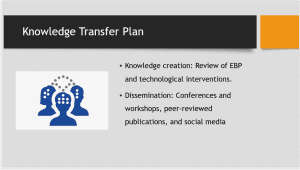
The knowledge transfer plan entails knowledge creation, evidence dissemination, organizational adoption, and implementation. The knowledge creation process involves gathering and reviewing evidence-based practices and technological interventions that can be used in the management of obesity. These technology innovations may include mobile apps, wearable devices, and online platforms that encourage physical activity, healthy lifestyles, and nutrition among families and children.
The dissemination strategy would entail publishing the research findings in reputable journals, positing the findings on social media, and holding conferences and workshops.
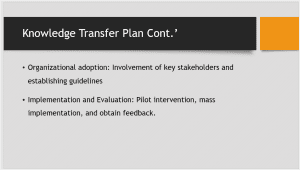
Organizational adoption would require engaging key stakeholders within the healthcare organization, including the administration, healthcare providers, and caregivers. Also, part of the adoption step is to implement guidelines that will integrate technology into current patient care and workflow practices.
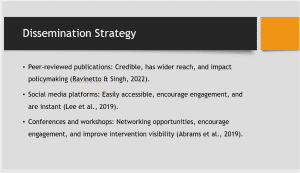
The dissemination strategy will entail the use of peer-reviewed publications, social media, and conferences and workshops. Peer-reviewed publications are key due to their credibility in that they have the trust of researchers and other healthcare professionals. Furthermore, these publications have a wider reach on professionals and the community, and they have a possible influence on policymaking and the making of clinical guidelines (Ravinetto & Singh, 2022).
Further, social media platforms make it easier to access broader audiences like caregivers, patients, and the general public. Also, they enable engagement between the audience and allow for instant dissemination of updates and findings (Lee et al., 2019).
Lastly, conferences and workshops are appropriate because they offer opportunities for networking with experts, peers, and stakeholders. Moreover, it offers opportunities for interactive discussions, feedback, and knowledge exchange with diverse audiences. Besides, enhanced visibility of the intervention within the healthcare professionals is guaranteed with presenting conferences (Abrams et al., 2019).
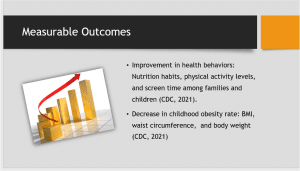
After implementation of the evidence-based practice, the measurable outcomes intended to be achieved include improvement in health behaviors and reduced childhood obesity rate (CDC, 2021). Health behaviors for assessment include nutrition habits, screen time, and physical activity levels. Notably, decreased childhood obesity rates are measured by looking at waist circumference, BMI, and body weight (CDC, 2021).
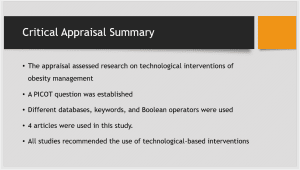
In my critical appraisal, I first identified the clinical issue as childhood obesity. Accordingly, using technology-based intervention to manage obesity was the evidence-based practice applied. This was followed by establishing a PICOT question, which read, “In children aged 5-12 years, does the implementation of technology-based interventions that promote healthy weight behavior, compared to traditional methods, result in a significant decrease in the prevalence of childhood obesity and overweight over 6 months?”
To obtain the relevant articles, I used four databases, namely, Google Scholar, PubMed, and Cochrane Library. I then used keywords like childhood obesity, physical activity, and technology-based interventions and Boolean operators like “OR” and “AND” to narrow down the four articles. Ultimately, I obtained four articles that recommended the use of technology-based interventions due to their impact on the management of obesity.
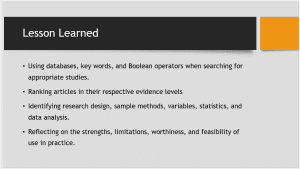
I have learned a lot from filling in the Evaluation Table within the Critical Appraisal Tool Worksheet Template. First, I have perfected my skills in using databases to get different articles and using Boolean operators and keywords to narrow down the search to specific studies of interest. Furthermore, I have managed to understand how to rank articles to the respective evidence level, which I found to be challenging at first. Also, after classifying and analyzing the four articles, I perfected the identification of research design, sampling methods, dependent and independent variables, different statistical methods, and data analysis. Lastly, I sharpened my critical thinking skills by analyzing the strengths, limitations, worthiness, and feasibility of using an intervention in practice.
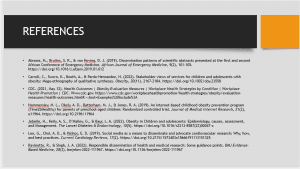
Thank you for your attentive participation. Here is a list of sources for further reading
ORDER A PLAGIARISM-FREE PAPER HERE
We’ll write everything from scratch
Question 
Create an 8- to 9-slide narrated PowerPoint presentation in which you do the following:
- Briefly describe your healthcare organization, including its culture and readiness for change. (You may opt to keep various elements of this anonymous, such as your company name.)
- Describe the current problem or opportunity for change. Include in this description the circumstances surrounding the need for change, the scope of the issue, the stakeholders involved, and the risks associated with change implementation in general.

Using Technology to Manage Childhood Obesity
- Propose an evidence-based idea for a change in practice using an EBP approach to decision-making. Note that you may find further research needs to be conducted if sufficient evidence is not discovered.
- Describe your plan for knowledge transfer of this change, including knowledge creation, dissemination, and organizational adoption and implementation.
- Explain how you would disseminate the results of your project to an audience. Provide a rationale for why you selected this dissemination strategy.
- Describe the measurable outcomes you hope to achieve with the implementation of this evidence-based change.
- Be sure to provide APA citations of the supporting evidence-based peer-reviewed articles you selected to support your thinking.
- Add a lessons learned section that includes the following:
- A summary of the critical appraisal of the peer-reviewed articles you previously submitted
- An explanation about what you learned from completing the Evaluation Table within the Critical Appraisal Tool Worksheet Template (1-3 slides)